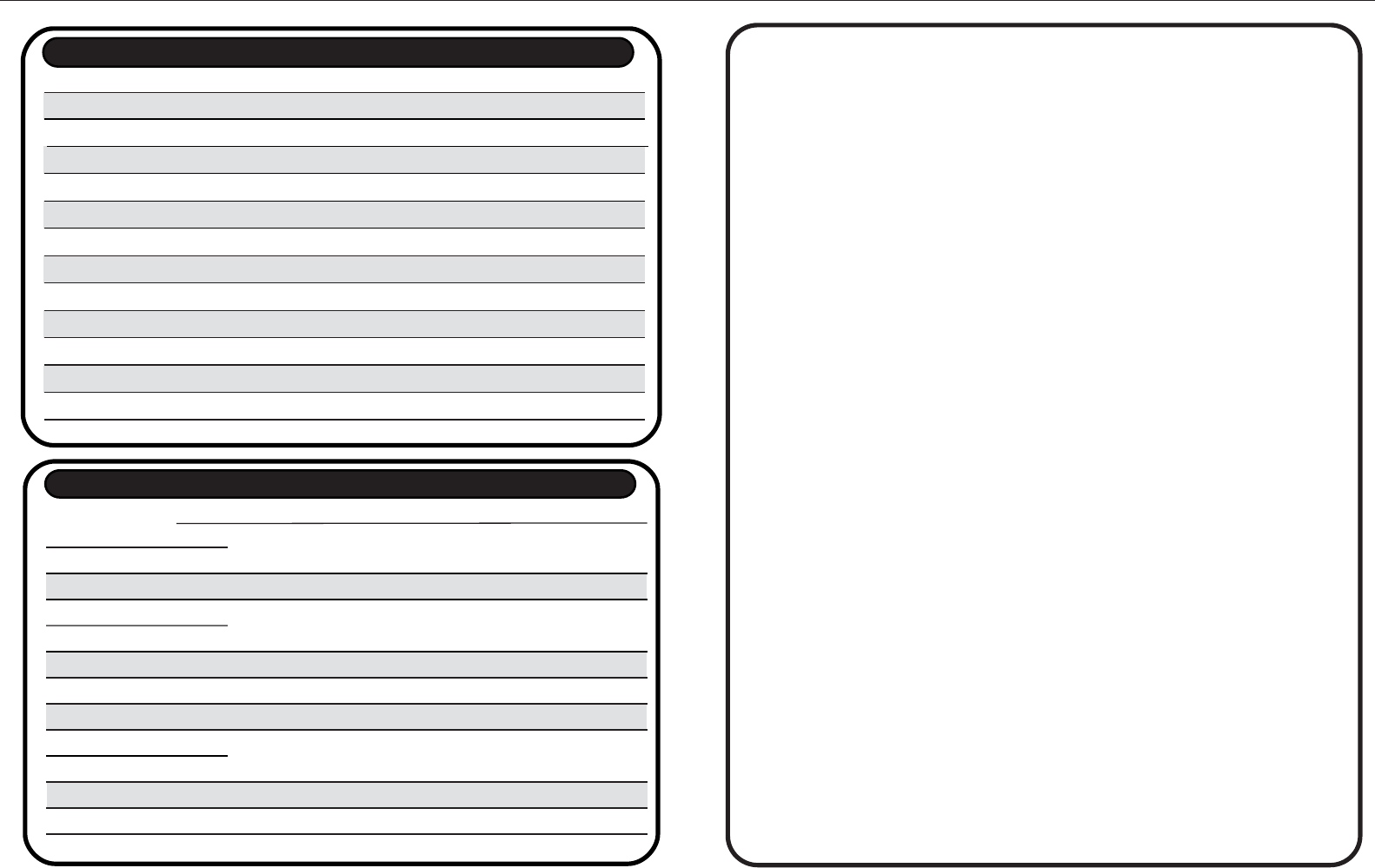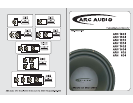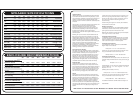
Qes Electrical "Q"
Qms Mechanical "Q"
Qts Total "Q"
Xmax (mm) One way Linear
Sd (cm2) Cone Area
SPL (dB) 1 watt @ 1 meter
RMS Power Continuous
MAX Power Music
Vas (cuft) Equivalent Volume
Re DC Resistance
Fs Resonant Frequency
IMP Impedance
SPEAKER SPECIFICATIONS
PORTED ENCLOSURES
Volume
Port Frequency
Port Area and Length
PHYSICAL DIMENSIONS
Displacement
Cutout Diameter
Mounting Depth
Port Quantity
Optimum Sealed
Small Sealed
SEALED ENCLOSURES
ENCLOSURE RECOMMENDATIONS
Useful Information
Ultimately the enclosure you build determines the performance
of your subwoofer.The size and vent tuning frequency, if you're
using a ported box, determine the low-frequency extension and
output of the subwoofer.We have designed the ARC Audio
subwoofer to perform well when used in both sealed and ported
enclosures.
The acoustics of your vehicle also influence bass response.The
small interior size of most cars and trucks boosts low
frequencies dramatically.You will need to use a smaller
enclosure then normal to achieve a flat bass response. As a
rule, below 50Hz (depending on cabin size), bass response
increases at about 12dB per octave as the frequency
decreases.This "Cabin Gain" adds significant bass output to the
subwoofer system.
We have given you two enclosure recommendations that are
listed on the previous page. One sealed and one ported.The
sealed enclosure design will, in most cases, give you the best
sound quality and take up less space in your vehicle.The ported
box design will offer more output then the sealed enclosure
(about 3 - 4 dB more), but it will reduce the power handling and
require more space to install.The recommended ported
enclosure is not designed for“competition SPL” performance, it
is designed for normal listening. It will increase the low
frequencies output and increase the overall volume while still
sounding good when properly tuned and installed.
A Note About Power Handling
ARC Audio woofers are designed to perform for years without
any problems.The RMS power noted under the specifications is
the recommended continuous power for long term use. All
woofers make heat. It is possible to dissipate only so much of
this heat.The woofer can handle as much as twice its rated
RMS power for short periods.This is the MAX power rating.
Continued use of this woofer at greater then the RMS power
rating will result a damaged (burnt) voice coil.This damage is
considered abuse and is NOT covered under the warranty.
Small Amp Myth
Under powering a woofer is fine.This woofer will suffer no
damage from a 100 watt amp if it is correctly tuned. However,
even a small amp that is being over driven (clipped) can destroy
a sub. Use your power wisely. Clipping can be heard as a dull
thud or a popping sound. If you hear any change in the tone of
your subwoofer this is a danger sign.TURN IT DOWN. If you
want more volume get a bigger amp or add another woofer.
Physics
"Energy cannot be created or destroyed, only change forms".
What does this mean? Your amp does not make power, it takes
power from your battery and converts it into a different form.
The subwoofer is just another kind of converter. It changes AC
voltage from the amp into changes in air pressure (that's all
sound is) and HEAT.The more energy being converted the
more heat. A speaker can not reproduce DC voltage (produced
when an amp clips) but this energy must go somewhere. It is all
converted into heat.This is why clipping is so dangerous to a
speaker.
A great deal of energy can also be lost in the enclosure. If your
box is not strong enough the sides will flex. It takes energy to
flex the box.This energy is not being converted into sound. In
short, the stronger the box the less energy will be lost.
So build it Strong.
This same thing can happen to the car body. Sound deaden, it
will sound better and hit harder.
Building an Enclosure
It is recommended that you use 3/4" MDF (Medium Density
Fiberboard) to build an enclosure. Glue all your joints with
yellow glue and secure then with screws or nails.
Make sure the enclosure will fit and that you have adequate
room to get it in and out of the vehicle.
Calculating EnclosureVolume
It is difficult to give exact box dimensions that are universal
for all cars and trucks. It is for this reason that you must be
able to calculate the space in which you have available in
order to achieve the proper air volume required.
Calculating External Volume
1)To calculate box volume, measure the outside Width x
Height x Depth of the enclosure.
Example 12" x 14" x 9" = 1512 cubic inches.
2) Next you must convert cubic inches into cubic feet.To do
this, you must divide the cubic inch total by 1728 .
Example 1512 cu in 1728 = .875 Cubic feet.
Calculating Internal Volume
1)To calculate the internal (net) volume of the above box you
must first multiply the thickness of the wood you are using by
Two (2).
Example:¾" x 2 = 1 1/2"
2) Next subtract 1.5" from each of the outside measurements
of the box.Width 12" -1.5" = 10.5" . Height 14" -1.5" = 12.5" .
Depth 9" -1.5" = 7.5"
3) Multiply the new totals (H x W x D)
Example: 10.5" x 12.5" x 7.5" = 984.375 cubic inches.
4) Next you must convert cubic inches into cubic feet.To do
this, you must divide the cubic inch total by 1728.
Example 984.375 1728 = .5696 cubic feet.
For additional information call ARC AudioTech support at:
209-543-8706
ARC Audio 4719 Greenleaf Cir #4 Modesto CA 95356 Phone:209-543-8706
15D415D28D48D2 10D2 10D4 12D2 12D4
.35cuft
.2cuft
.6cuft
34Hz
1
2"d X 12"L
.04cuft
7.125"
4.75"
.35cuft
.2cuft
.6cuft
34Hz
1
2"d X 12"L
.04cuft
7.125"
4.75"
.65cuft
.5cuft
.9cuft
32Hz
1
3"d X 15"L
.05cuft
9.25""
5.5"
.65cuft
.5cuft
.9cuft
32Hz
1
3"d X 15"L
.05cuft
9.25""
5.5"
.90cuft
.65cuft
1.30cuft
30Hz
1
3"d X 12"L
.07cuft
11.125""
6.0"
.90cuft
.65cuft
1.30cuft
30Hz
1
3"d X 12"L
.07cuft
11.125""
6.0"
2.25cuft
1.5cuft
3.0cuft
32Hz
2
4"d X 18"L
.17cuft
11.125""
8.0"
2.25cuft
1.5cuft
3.0cuft
32Hz
2
4"d X 18"L
.17cuft
11.125""
8.0"
15D4
2 or 8
15D2
1 or 42 or 8
8D4
1.95/7.8
24.7Hz
1 or 4
8D2
.95/3.8
22.7Hz
1 or 4
10D2
.925/3.7
24.5Hz
2 or 8
10D4
1.95/3.9
25Hz
1 or 4
12D2
.975/3.9
21Hz
2 or 8
12D4
1.75/7.0
22Hz
.317
3.331
.289
1.7
231 cm2
15mm
85.4dB
150W
300W
.367
3.572
.332
1.55
15mm
231 cm2
85.6dB
150W
300W
.357 .365 .298 .317
4.56 5.12 4.29 4.35
.331 .341 .278 .317
2.0 2.25 4.76 4.41
15mm 15mm 16mm 16mm
350 cm2 350 cm2 530 cm2 530 cm2
87dB 87dB 89.dB 89dB
250W
500W
250W
500W
350W
700W
350W
700W
.90/3.6
20.4Hz
1.8/7.2
20.5Hz
.443 .431
2.462 2.762
.375 .373
9.99 9.88
18mm 18mm
840 cm2 840 cm2
89.dB 89dB
750W
1500W
750W
1500W




